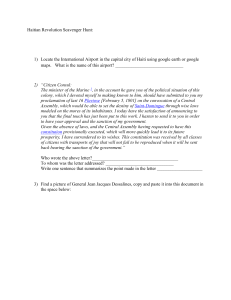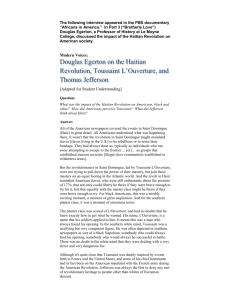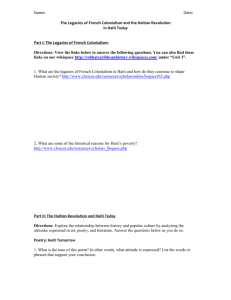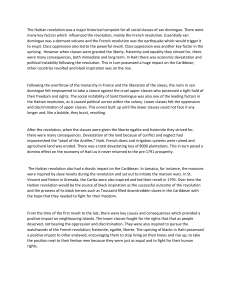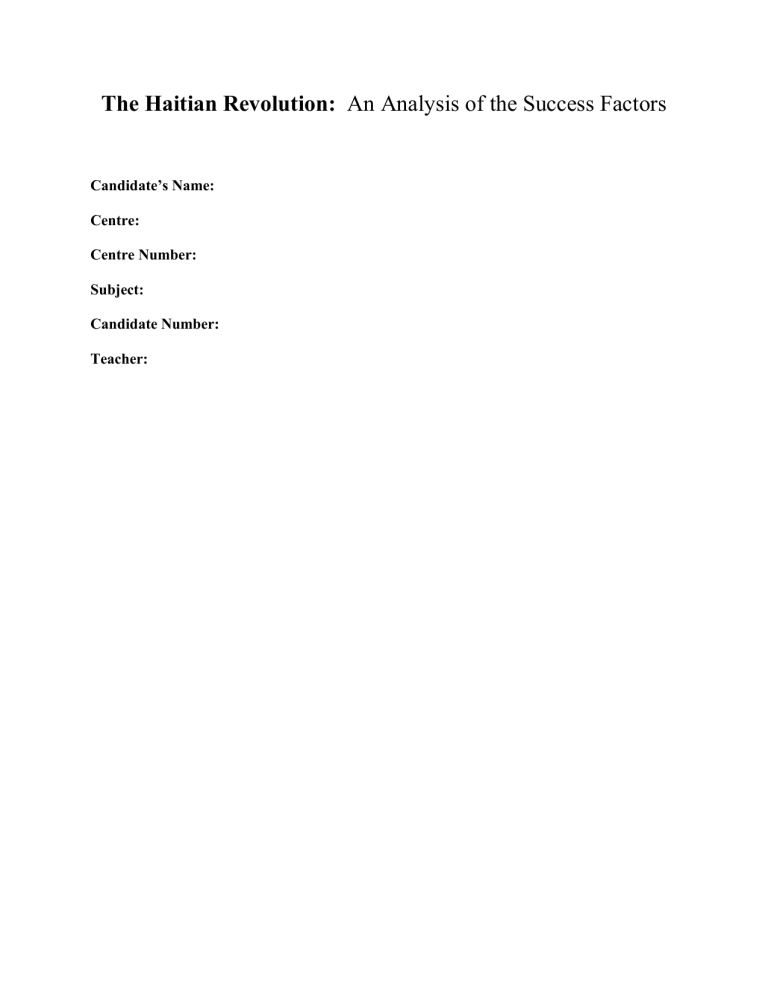
The Haitian Revolution: An Analysis of the Success Factors Candidate’s Name: Centre: Centre Number: Subject: Candidate Number: Teacher: Rationale Though it poses unknowledgeable to some, during the colonial era Haiti was the wealthiest country in the Western Hemisphere. Additionally, during this time, it hosted the greatest and only successful enslaved revolt in the West Indies. This later influenced neighbouring enslaved populations to attempt such an action against their colonial powers. However, the thought of Haiti ever being wealthy might seem contrary to the unhistorical mind when compared to its present state. It is because of the researcher’s knowledge and fascination of the Haitian Revolution why this topic is chosen. The researcher will validate that the determinants of the successful Haitian Revolution was the response of a disregarded but yet organized race against their superiors. Context ° (Map of Haiti) Haiti’s slave system, at its height (1788-1789) there were 8,000 plantations; 793-sugar, 3145indigo, 33117- coffee, 789-coton and the remaining producing other products. With a population 405,564 enslaved blacks, on average Haiti generated 280,000,000 francs.[1] This made Haiti very valuable and a very prosperous country and made it extremely important to France. This fact is further strengthened by Carolyn E. Fick who states, “At its height in 1789, the French colony of St. Dominique, the Pearl of the Antilles and the pride of the France, was by far the wealthiest and most flourishing of the slave colonies in the Caribbean.”[2] Despite its wealth, the Haitian Revolution was fundamentally conceived in France and would change the course of chattel slavery. Haiti adopted the slogan of the infamous French Revolution, and the mulattoes and Blacks began clamouring for “Liberty, Equality and Fraternity”. The success of this revolt, which was sparked the Enlightenment along with the French Revolution as a result of social inequality, was a combination of many factors which include, the influence of Vincent Ogle, excellent leadership skills and strategic planning, outnumbered forces, religion, weaponry, and diseases. Enlightenment and the French Revolution As in any stratified society, underprivileged classes were desperately in a state of exploitation. With connection to Haiti, France was experiencing several ideological changes known as the Enlightenment, which resulted in the French Revolution. The underprivileged class believed that ancient and traditional institutions and ideologies should be done away with and that everyone should have a voice in society’s operation. As a result, they collectively rose up and began rioting for their rights as seen in the ‘Fall of Bastille’ and the ‘Tennis Court Oath’. As French Philosopher, Rousseau stated, “Men are born free, but everywhere he is in chains.” This spoke of the oppression of certain men and was taken to heart by those who suffered. Fortunately, France on August 26th, 1789 declared the ‘French Declaration of the Rights of Man ‘which states, “Men are born free and equal in rights.” This added to the French Revolution’s slogan of, “Liberty, Equality and Fraternity” and was a strengthening component to the upcoming uprising in its most prestigious colony. With France being the mother country of St. Domingue, this enlightened the suppressed groups that equality belonged to them as well. These events gave the perfect opportunity for such groups to rally for socio-political changes. Social Stratification St. Domingue comprised of a three-tier stratified society. To the pinnacle of the social chart were the whites, specifically, the wealthy and superior whites who held supremacy of all sorts. The wealthy whites were referred to as the grand blank. Consecutively were the poor whites, also referred to as the petite blank. Even though they were white, they had no political power, but merely because of their colour, they were socially higher than the following classes. Next were the mulattoes, the offspring of white planters and black slaves. They inherited wealth from their white fathers which made them richer, in some cases, than the petite blank. However, because of their black lineage, it was merely impossible to be above any white, whether rich or poor. Finally, as in any West Indian colonial society, the enslaved blacks, who laboured and were exploited on the plantations, were relegated to the bottom of society with no possibility of upward social mobility. From the slogan of the French Revolution ‘Liberty, Equality, Fraternity’, the mulattoes believed that this includes them and they should not be held in contempt because their lineage has ‘a spot of black’. While the free coloureds were already living a better life than the slaves, they too wanted some of the socio-political privileges the whites possessed, while the Blacks just wanted to be free from the suppressing slave system. Luckily, the decree of May 15, 1791 made free coloureds born legitimately of free parents to obtain equal rights to whites. This declaration was seen as a progress for success. However, in the midst of political chaos, the excluded Blacks began to formulate their campaign for freedom. From this one can say that the struggle of social inequality, specifically between the mulattoes and white, served as an opportune distraction to allow the blacks to formally organize themselves to enter into the racial struggle. Such high levels of social inequality enraged these groups to violently protest and revolt against their oppressors even though their life already hung on the periphery of the society. In addition, as posited Karl Marx, when an exploited and labouring class (Proletariat) realizes the true nature of their oppression (Class-Consciousness) by the capitalist class (Bourgeoisie), conflict will occur. This was simply the recipe of the Haitian Revolution, a society of deepseated prejudices. Moreover, everything presented simply goes to justify Fick’s statement that, “Racial conflict and class contradictions had always been deeply embedded in the very nature of St Dominguez’s colonial structure and slave society.”[3] The Influence of Vincent Ogle A wealthy mulatto by the name of Vincent Ogle led this suppressed group into a rebellion against the high-ranking whites. With the Declaration of the Rights of Man, Ogle was sent to the National Assembly in France to acquire certain privileges (citizenship) for the suppressed groups. Failing in this mission, he returned to Haiti and took matters into his own hands. However, prior to arriving in St. Domingue, Vincent Ogle received a sum of thirty pounds from abolitionist Thomas Clarkson, with which was used to purchase arms in the United States and then transported to Saint Domingue. Unfortunately, his army was outnumbered and were easily defeated. Ogle and another rebel, Chavannes, were captured, tried, proven guilty and executed. However, as a result of their gruesome death, the National Assembly declares the May 15, 1791 decree, as mentioned, to attempt to prevent any more social conflict. From this it is valid to say, even though the Ogle rebellion itself failed, it added much fuel to the already impending Haitian Revolution, and can be regarded as the ‘morning star’ of the Haitian Revolution. Excellent Leadership and Strategic Planning It is without question that in order for any sort of insurrection as one as the Haiti Revolution to be successful, an indisputable key element is good leadership. Leadership qualities characterized by strategic planning, manipulate skills, delegation, resilience and determination. Indeed, the St. Domingue uprising was not an “overnight thought,” but rather, was thoroughly planned by its early leaders. The slaves in the North had been preparing themselves for weeks before the dreadful 22 August night where upon a signal; the plantations would be set ablaze. These early leaders included Duty Bookman, Jean not Bullet, Jean-Francois and Georges Bissau, who all met on 14th August at Lenora de Mazy in Mourned-Rouge to add the final details of the planned insurrection. Such qualities were exemplified by other revolutionary leaders such as Dessalines, Christophe and especially Toussaint, who all made Haiti’s independence possible. Of course there were others but the previous mentioned were to the forefront of the fight to freedom. Before the insurrection, representative delegates of different plantations all gather at a specific location to plan how this uprising should take its course. For the leaders, it was absolutely important that their opposing actions against their former masters were done correctly as to not impede their plans of attack. The revolution commenced with the slave from the North, where C.L. R James referred to as “the pride of the colony” because it was the location of the main ports.[4] Swiftly moving, the insurgents did not hesitate to spare any whites with the exception of doctors who will help to medically aid the blacks. The Blacks’ army was thoroughly organized and well-disciplined and this could have only been possible with brilliant strategic leadership skills. Unlike the majority of the enslaved population, as he was once a slave, Toussaint was not illiterate. Toussaint was not initially to the forefront but eventually made his way as commander. Toussaint’s manipulating leadership skills drove out British and Spanish presence until Haiti’s independence. Additionally, Toussaint was a master of the arts. He developed superior militaristic skills as he fought against different forces within Haiti during the entire conflict. With such manipulating skills, Toussaint fought alongside the Spanish against the French in St. Domingue. He did this in an effort to fight against the French Civil Commissions Sonthonax who was withholding general emancipation, until it was finally granted on August 29, 1793. This granting was the victory the slaves in the North desired. However, even though their racial class was free, their country wasn’t, as complete success can only mean independence. Such leadership skills exemplified through all the leaders were imperative to the success of Haitian Revolution. Even though some fell in battle such as Bookman, the masses kept on fighting until the last blood of enemy was shed. It was this determination and innate feeling for freedom which the leaders longed for, which resulted in their excellent leadership skills to drive Haiti to victory. Outnumbered Forces In addition to such courageous determination, the physical strength of the black masses was a major contribution to Haiti’s success. With statistics from David Gigues, Saint Dominguez’s population consisted of approximately 500,000 slaves, 40,000 whites and over 30,000 free coloured (mulattoes). During the period 1785-90 over 30,000 captured Africans were imported each year.[5] In addition, African-born slaves were more defiant than Creoles, and as a matter of fact, they were the ones who set up the maroon societies as a means of resistance. The ratio of blacks to whites gave the blacks a clear cut advantage, that even if there troops diminished, they could be easily replenished. Initially however, only whites were eligible to serve in the armed corps which was leading them to their detriment. As the blacks drastically outnumbered all other groups, the white-only armed corps deemed insufficient to counterattack the insurgent slaves. Also, because of the French Revolution, Haiti’s garrison was depleted. As a result, Governor Blanchelande issued a proclamation allowing all free persons of colour and mulattoes to take up arms, along with the white armed corps, and fight against the rebellious blacks. This action revealed the numerically weakness of the white-only forces when compared to the slaves. As the insurgent slave numbers grew by the thousands daily, obviously more counterforce would be needed, especially at the rate of destruction. The blacks’ large numbers allowed them to plunder plantations in different areas simultaneously, which disallowed the whites to organize opposing forces efficiently. To display their level of physical strength, within eight days the salves devastated seven parishes and destroyed 184 sugar plantations...”[6] Weaponry With the level of magnitude of physical rioting as portrayed in the swiftly moving blacks, another key aspect of its success is definitely weaponry. In the initial stages of the revolt, the slaves were, to an extent, vulnerable. This was so because the only available weapons in their possession were inferior weaponry such as pointed sticks, knives, machetes and various farm implements. However, as the slaves rapidly and thoroughly plunder plantations, they acquired more superior weapons from the plantation. From their ransacking they acquired guns, ammunition, rifles and canons, which would obviously improve their warfare strategies. Also worthy to mention as a result of Toussaint’s excellent leadership, his diplomatic alliances with the US, he re-established commercial trade and imported an estimate of 30,000 muskets with large quantities of ammunition from Britain and the U.S. These weapons were used to help defeat the mulatto enemy, Andre Rogued.[7] However, what made the Blacks successful up to this point was they used the element of guerrilla warfare where they would disband and retreated to the hills when the royalists press against them. This was done to preserve and reorganize their troops. They camouflaged traps, fabricated poison arrows and feigned cease fires to lure the enemy troops into ambush. Also, with money acquired from raiding the plantations, it was used to purchase necessities, especially ammunition from neighbouring Santo Domingo. Prior to this, the Blacks were using simple, inferior tools while the planters counter attacked with sophisticated and superior guns and canons. However, as the revolution became more politically complicated, the elite class eventually began to allow compromised blacks the right to carry on arms and serve in the military. However, as the black masses continue in the rivalry, regardless of whatever side of the spectrum they were on, they used their weapons to fight their enemies and to push towards their ultimate goal. Religion On the other hand, as one hears the word ‘revolt’, one might think solely of physical altercation. On the contrary, an element totally opposite from a physical factor aided in Haiti’s success. Religion can be deemed as important as all the other factors. Religion provided the spiritual and psychological driving force for the slaves to fight such as brutal and bloody revolt. There were several socio-political-religious activists engaged in this complex revolt. Most revered of these figures was Duty Bookman, a voodoo priest. Before the set date of the insurrection, a voodoo religious ceremony was celebrated in the woods of Bois-Caiman. Bookman along with a priestess officiated where they invoked the gods by the sacrificial killing and drinking of a pig’s blood. During the ceremony, Bookman gave his charge to the attendees saying about their god: “This god who is good orders revenge! He will direct our hands: he will aid us.” This mentally propelled the slaves into full confidence and bravery to fight against their enemies. Ironically, the whites highly feared voodoo which also gave the black masses an advantage. In addition to Bookman as a political-spiritual leader, another of similar stature was a young slave leader named Hyacinth. He was a revered voodoo leader who led certain slave bands during the conflicting time. He religiously carried a talisman made of horsehair, which he waved before his troops to protect them and to reinforce their defiance and determination, crying, “Forward! Don’t be afraid; it’s only water coming out of the cannon”. Also, Alou, an Africanborn of the Nag nation, and a fervent voodoo adept and chief leader over ten thousand troops also served in an identical position as the other spiritual leaders. These religious figures utilized their spiritual influence to transform the blacks from mere slaves to fierce freedom fighters. According to Fick, “Voodoo provided a medium for the political organization of the slaves, as well as an ideological force, both of which contributed directly to the success of what became a virtual blitzkrieg attack on the plantation across the province.”[8] Diseases For a more physical contributing factor, the role of disease epidemic was opportune. During the colony’s civil war prior to independence, Napoleon Bonaparte ceased power in France and commissioned his brother-in-law, Victor-Emmanuel Leclerc, to regain St. Domingue for France and to reinstitute slavery. Although this was the conceptualized motive, it never materialized. During the first two weeks of French’s arrival, two thousand European troops were already in the hospital, three-quarters of them sick and the rest wounded. Shortly after, five hundred more succumbed to the unforgiving climate, with an additional one thousand wounded. The French expeditionary were faced with an unaccustomed climate and above that, epidemic disease. The troops arrived in February 1802, and by April they encountered one of the deadliest epidemics of yellow fever. Within these first three months, the epidemic claimed one-third of Leclerc’s troops. By June, European troops were dying at a rate of thirty to fifty per day. At the end Leclerc and his troops failed to accomplish their motives.[9] This timely intervention of disease proved to be the final blow to the French forces. Resultantly, the fatalities of the French allowed St. Domingue to be remained under nonwhite rule which the mulattoes and blacks wanted, even though they were in conflict with each other. Furthermore, other European forces present, such as the British and Spanish, also became victims of the epidemic. Even though there was fatality amongst the blacks, diseases proved to be a helper in their fight against the enemies. As presented, this highly complex battle for freedom comprised of a multiplicity of combinations. It would not be fair to say that one factor was more important than other, but all equally contributed to the way of success. With the impact of the Enlightenment, French Revolution and Social Inequality, the way was paved for such a brutal conflict. With the various factors such as the rebellion of Ogle, excellent leadership, physical forces, weaponry, religion, and diseases, they allowed Haiti to achieve its independence of France on 1st January 1804, marking a total victory. In final, describing the victorious Haitian Revolution, Laurent Dubois states, “By creating a society in which all people, of all colours, were granted freedom and citizenship, the Haitian Revolution forever transformed the world...”[10] Bibliography · Buckles, Hilary. and Verne Shepherd. ­Caribbean Freedom. Jamaica, Ian Randle Publishers, 1996. · Fick, Carolyn E. The Making of Haiti. Tennessee: The University of Tennessee Press, 1990. · Dubois, Laurent. Avengers of the New World. Cambridge, Harvard University Press, 2004. [1] Robert Lacerate, “Economy and Society from Emancipation to the Present: The Evolution of Land and Labour in the Haitian Revolution 1791-1820,” Caribbean Freedom, eds. Hilary Buckles and Verne Shepherd. (Jamaica: Ian Randle Publishers, 1996) 42. [2] Carolyn E. Fick, the Making of Haiti: The Saint Domingue Revolution from Below. (Tennessee: The University of Tennessee Press, 1990) 15. [3] Carolyn E. Fick, the Making of Haiti: The Saint Domingue Revolution from Below. (Tennessee: The University of Tennessee Press, 1990) 192. [4] C.L.R James, “French Capitalism and Caribbean Slavery,” Caribbean Slave Society and Economy, Ed. Hilary Buckles and Verne Shepherd. (Jamaica: Ian Randle Publishers. 1991) 134. [5] David Gigues. “The Haitian Revolution,” Caribbean Slave Society and Economy, Ed. Hilary Buckles and Verne Shepherd. (Jamaica: Ian Randle Publishers. 1991) 402. [6]Carolyn E. Fick , The Making of Haiti: The Saint Domingue Revolution from Below. (Tennessee: The University of Tennessee Press, 1990) 150 [7] Mats Lundhal, “Economy and Society from Emancipation to the Present: Toussaint L’Ouverture and the War Economy of Saint Domingue,” Caribbean Freedom, 1796-1802. Ed, Hilary Buckles and Verne Shepherd. (Jamaica: Ian Randle Publishers 1996) 3. [8]. Carolyn E. Fick, The Making of Haiti: The Saint Domingue Revolution from Below. (Tennessee: The University of Tennessee Press, 1990) 94. [9], Carolyn E. Fick, The Making of Haiti: The Saint Domingue Revolution from Below. (Tennessee The University of Tennessee Press. 1990) Pages 210-228 [10] Laurent Dubois. Avengers of the New World: The Story of the Haitian Revolution. (Cambridge: Harvard University Press. 2004) 6
